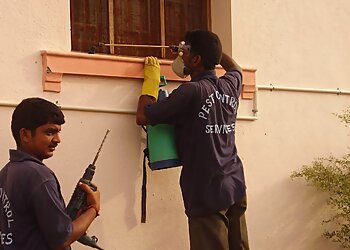Flea Control in Chicago: Specialist Therapy for Flea Infestations
Flea Control in Chicago: Specialist Therapy for Flea Infestations
Blog Article
A Comprehensive Guide to the Different Sorts Of Pest Control Methods
With the myriad of pest control approaches readily available, it can be overwhelming to find the most efficient option for a specific bug issue. In this extensive overview, we will certainly check out these various types of bug control approaches, providing understandings into their applications and advantages. By the end, you will have a clearer understanding of which technique might be the best fit for your parasite control requirements.
Chemical Pest Control Techniques

One typical sort of chemical bug control is pesticides. Pesticides are chemical compounds that are particularly created to eliminate or ward off bugs. They can be applied in different types, such as sprays, baits, or cleans. Pesticides target details pests, such as insects, termites, or ants, and can be made use of both inside and outdoors.
An additional kind of chemical insect control is rodenticides. These are chemical materials created to control populaces of rodents, such as rats and computer mice.
Herbicide, also recognized as herbicides, are one more kind of chemical bug control method. Herbicides are designed to uniquely kill undesirable plants, called weeds, without creating injury to preferable plants. They are generally used in farming, landscape design, and gardening to manage the growth of unwanted greenery.
While chemical parasite control methods can be extremely effective in getting rid of parasites, it is necessary to use them judiciously and comply with safety and security guidelines. Overuse or abuse of chemical pesticides can have adverse effect on human wellness and the atmosphere. It is vital to use these methods properly and take into consideration different insect control strategies whenever feasible.
Biological Pest Control Techniques
Organic bug control approaches entail using living microorganisms or natural compounds to take care of and regulate pest populations. Unlike chemical approaches, which commonly count on synthetic pesticides, biological control approaches utilize the natural enemies of insects to control their populations. This technique is considered more ecologically pleasant and lasting, as it reduces using unsafe chemicals and reduces the threat of chemical resistance.
One extensively made use of biological pest control method is the introduction of all-natural killers or bloodsuckers. As an example, ladybugs are introduced to control aphids, while certain wasp types are launched to target caterpillars. These killers and bloodsuckers feed upon parasites, reducing their numbers and preventing infestations.
Another organic control approach is the usage of pathogens. Certain microorganisms, infections, and fungis can be utilized to infect and eliminate certain insects. For example, the bacterium Bacillus thuringiensis is typically utilized to regulate caterpillars, as it creates toxic substances that are lethal to these parasites.
Biological control methods can additionally include making use of pheromones or natural materials that interrupt the mating patterns of parasites. By hindering their reproduction, these techniques help to lower pest populations over time.
While organic pest control approaches are typically reliable, they may call for longer durations to achieve preferred outcomes compared to chemical approaches. Furthermore, mindful factor to consider should be offered to the selection and launch of natural opponents to avoid unexpected harm to beneficial organisms or ecosystems.
Physical Insect Control Approaches
To properly manage and regulate pest populaces, alternative bug control methods understood as physical parasite control techniques are employed. These techniques involve using physical barriers, traps, or devices to avoid insects from accessing or harming building. One common physical pest control technique is making use of displays or webs to keep insects out of structures or yards. These displays are normally constructed from fine mesh material that enables for air flow while protecting against insects from going into. Your Domain Name An additional physical parasite control method is the setup of fencings or walls to keep larger pests, such as deer or rabbits, out of gardens or exterminator business agricultural fields. These obstacles literally obstruct the parasites' accessibility to the location, decreasing the capacity for damage. Furthermore, traps and gadgets can be made use of to capture or fend off bugs. For example, sticky traps can be put in areas where insects are an issue, and the bugs come to be stayed with the sticky surface. Ultrasonic tools can additionally be used to produce high-frequency audios that are undesirable to bugs, causing them to leave the area. Physical insect control techniques are an eco pleasant choice to chemical pesticides, as they do not count on making use of hazardous chemicals.
All-natural Bug Control Techniques
Natural bug control methods supply a sustainable and environment-friendly technique to handling and removing insects. These methods prioritize making use of natural materials and biological agents, decreasing the requirement for chemical pesticides that can harm the environment and human wellness. One of the most usual all-natural insect control approaches is biological control. This entails introducing natural killers or bloodsuckers to exploit or parasitize the pests. As an example, ladybugs are typically presented to yards to control aphid populaces. One more all-natural method is using repellents stemmed from plants. Particular plants, such as marigolds, lavender, and peppermint, give off aromas that repel insects like insects, flies, and ants. In addition, cultural control techniques can be utilized to stop and manage bug problems. This consists of correct cleanliness, routine upkeep, and advertising biodiversity in the yard. Turning crops, eliminating yard particles, and motivating all-natural killers can assist stop the buildup of insects. By embracing these natural pest control methods, individuals and communities can successfully take care of parasites while decreasing the adverse effect on the setting and human health and wellness.
Integrated Bug Administration (IPM)
Integrated Parasite Monitoring (IPM) is an extensive and organized approach to pest control that integrates numerous techniques and strategies to properly take more tips here care of parasites while lessening making use of chemical pesticides. IPM aims to preserve parasite populations listed below the financial injury degree by using a combination of social, organic, and chemical control methods.
Cultural control techniques entail modifying the environment to make it less desirable for pests. This can consist of practices such as crop rotation, appropriate cleanliness, and using resistant plant selections. By developing negative conditions for pests, cultural control methods can substantially reduce insect populations.

Chemical control approaches are utilized as a last option in IPM. They include the targeted and sensible use pesticides to take care of bug populations. Unlike standard bug control approaches, IPM intends to reduce using chemical pesticides by using alternate techniques.
Integrated Pest Monitoring (IPM) is a positive method that focuses on lasting bug management as opposed to depending only on responsive steps. By combining numerous control methods, IPM provides a much more sustainable and eco pleasant technique to pest control.
Conclusion
In verdict, this short article has actually offered a comprehensive summary of the various kinds of bug control methods. It reviewed chemical, biological, physical, and all-natural parasite control approaches, in addition to the incorporated insect monitoring method. By recognizing these various approaches, people can make educated decisions on which insect control approach is most suitable for their particular demands and choices. Effective insect control is essential in preserving a healthy and balanced and pest-free environment.
Report this page